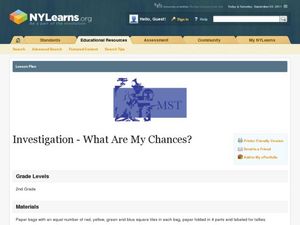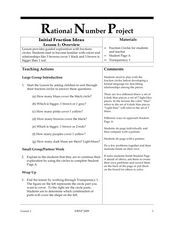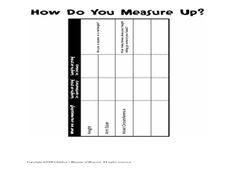Curated OER
Equivalent Fraction Paper Strips
Young learners compare the relative values of fractions by making physical representations. They fold and label strips of paper that are equal in length to represent "one whole" and the equal parts that fractions represent. Also, they...
Curated OER
Finding Equivalent Forms For Positive Rational Numbers
Learners discuss the relationship between and the equivalent forms of rational numbers. They will convert numbers from decimals to fractions, understanding they are equivalent, but just different forms.
Mathematics TEKS Toolkit
Am I Related to Myself?
Elementary or middle schoolers use ratios to discover some nearly constant relationships between measurements of parts of the human body. They find and record pairs of measurements and determine the relationship between the pairs. Pupils...
Alabama Learning Exchange
Sky High
How are skyscrapers built? What does it take to make a structurally sound building? How can one work within a budget to complete a building project? These guiding questions will be investigated and answered within a hands-on lesson....
Curated OER
Investigation--What Are My Chances?
Seventh graders investigate theoretical and experimental probability by conducting a series of experiments with multiple trials, comparing results, combining results and making conclusions. They express probabilities as fractions,...
BW Walch
Solving Systems of Linear Equations
Solving systems of equations underpins much of advanced algebra, especially linear algebra. Developing an intuition for the kinds and descriptions of solutions is key for success in those later courses. This intuition is exactly what...
Curated OER
Introduction to Exponents
Problem solve using exponents. Pupils read One Grain of Rice: A Mathematical Folktale and write powers to represent amounts from the story.They compare actual solutions to their predictions and play a game to practice using...
Curated OER
Equivalent Fraction Munch with Pizza Pie
Students demonstrate fractions and mixed numbers using concrete pictorial models of pizza. They relate symbols to the models.
Pennsylvania Department of Education
Dividing with Fractions
Fifth graders explore the strategies to solve word problems using multiplication and division. In this problem solving lesson, 5th graders recognize the relationship between multiplication and division to solve problems. Students...
Curated OER
Filling the Glass (Water, Air, and Fractions)
Students predict which of two glasses is 1/2 full using visual estimation, height measurement, and liquid measurement methods. Mathematical equations to accurately solve the problem are determined and verified.
Curated OER
Multiplying and Dividing Fractions with Post It Notes
Seventh graders experiment with measurement as it relates to the algorithm for dividing fractions. In this fractions lesson, 7th graders work in groups to establish how many post-it notes it takes to fill an 8 X 11 piece of paper. Using...
Curated OER
Initial Fraction Ideas Lesson 1: Overview
Students use the colors in their fraction circles to answer short answer questions about fractions. In this fractions lesson plan, students count the colors of their fraction circles and add them together to make fractions.
Curated OER
A Fraction of the Cost
Students use various coin denominations to explore the concept of fractions. They demonstrate an understanding of the fractions 1/2 ($.50), 1/4 ($.25), 10ths ($.10) and 20ths ($.05) by using fraction circle pieces to create whole units...
Curated OER
Unit 5: Worksheet 1 - Ratio
In this ratio worksheet, students identify and compare colors of marbles in a bag. They also compare lengths. Students write ratios to identify their comparisons. This three-page worksheet contains approximately 40 ratio problems.
Pennsylvania Department of Education
Problem Solving by Using Multiplication to Solve Division Problems
Students use index cards, counting cubes, and their own understanding to identify how division problems can be solved by using multiplication. In this division lesson plan, students use their multiplication skills to solve division...
Curated OER
The Math Of African Music
Students practice rhythms and fractions on African drums in this Music lesson plan mixing Math skills and music notation. The lesson plan also includes ideas for assessment and state and national benchmarks met.
Curated OER
Measuring Beads
Students compare the weight of the students's favorite soft toys directly and then indirectly using beads.
Curated OER
How Do You Measure Up?
Students measure their body. In this measurement instructional activity, students use a string to measure their height and the circumference of their head. They record this information on the worksheet provided and answer questions as a...
Curated OER
Horatio's Ratios
View a PBS video entitled Horatio's Drive and explore Horatio's Ratios. Collaborative learners form groups to use Mapquest to determine distances covered. They generate the mathematical averages, ratios, and rates in order to calculate...
Curated OER
Graphing Our Marbles
Students collect information pertaining to marble colors found in their bag; then creating a spreadsheet in order to make a chart representing their findings using Microsoft Excel. Students will present their results to small groups.
Curated OER
Shots, Standings, and Shopping
Rates and ratios can easily be applied to real-world situations. Learners explore a series of websites in order to procure comparable data. They define ratios and rates, view videos, and use the internet to explore how ratios and rates...
Curated OER
Capture/Recapture
Students use proportions to estimate the size of populations. They describe the data with using a graph or table of the estimate. Students use descriptive statistics to calculate mean, median, and mode. They also compare and contrast an...
Curated OER
Skateboards
Students examine two plants that make skateboards. They practice converting fractions to percents in real life applications.
Curated OER
A New Life
Middle schoolers write a paper about how their life would be different if fractions, decimals and percents did not exist. The teacher leads a discussion after the papers are written.























